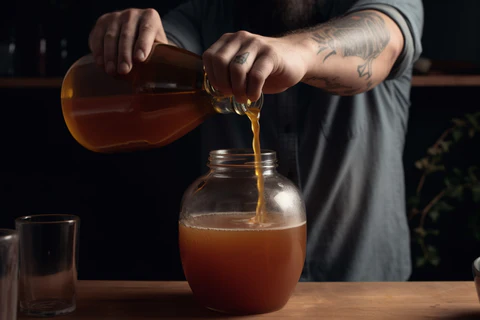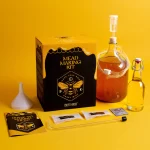What is Kombucha?
Kombucha is a fermented, lightly effervescent tea drink that has been enjoyed for centuries. It is made by combining sweetened tea with a symbiotic culture of bacteria and yeast, often referred to as a SCOBY (Symbiotic Culture Of Bacteria and Yeast). This unique culture initiates a fermentation process that transforms the sweet tea into a tangy, slightly fizzy beverage.
The origins of kombucha can be traced back to ancient China, where it was prized for its purported health benefits. Over time, the beverage spread across Asia and eventually made its way to Europe and the rest of the world. Today, kombucha has experienced a resurgence in popularity, particularly among health-conscious consumers seeking probiotic-rich, low-sugar alternatives to sodas and other sugary drinks.
One of the primary reasons for kombucha’s popularity is its potential health benefits. The fermentation process produces a range of beneficial acids, enzymes, and probiotics that may support digestive health, boost immunity, and provide antioxidant properties. While more research is needed to confirm these claims, many kombucha enthusiasts report improved gut health, increased energy levels, and overall well-being after incorporating the beverage into their diets.
Table of Contents
Why Brew Your Own Kombucha?
Brewing your own kombucha at home offers several compelling advantages. Firstly, it allows for significant cost savings compared to purchasing pre-bottled kombucha from stores. The initial investment in a brewing kit is quickly recouped, and the ongoing costs of producing homemade kombucha are minimal, primarily consisting of tea, sugar, and any desired flavorings.
Secondly, home brewing provides the opportunity to experiment with creative flavor combinations that may not be readily available in commercial offerings. You can infuse your kombucha with a wide range of fruits, herbs, spices, and even vegetables, tailoring the taste to your personal preferences. This level of customization allows you to explore unique and exciting flavor profiles.
Moreover, homemade kombucha is a natural, probiotic-rich beverage that supports a healthy gut microbiome. By brewing your own, you can ensure that your kombucha is free from unnecessary additives or preservatives often found in store-bought varieties. The fermentation process encourages the growth of beneficial bacteria and yeasts, which contribute to overall digestive health and well-being.
What’s Included in a Kombucha Brewing Kit?
A typical kombucha brewing kit comes equipped with all the essential components needed to start your home brewing adventure. At the heart of every kit is a SCOBY, an acronym for “Symbiotic Culture of Bacteria and Yeast.” This gelatinous, pancake-like culture is the magic ingredient that kickstarts the fermentation process, transforming sweet tea into the tangy, fizzy kombucha we know and love.
In addition to the SCOBY, most kits include a glass brew jar or vessel, often with a spigot for easy bottling. The jar’s wide mouth allows for easy addition of ingredients and removal of the SCOBY during subsequent batches. Some kits may also provide a breathable cover, such as a tightly woven cloth, to allow proper air circulation while keeping contaminants out.
To get your first batch started, kombucha brewing kits typically come with a starter liquid – usually a small amount of unflavored, raw kombucha from a previous batch. This starter tea provides the necessary bacteria and yeast to inoculate your sweet tea mixture, ensuring a successful fermentation.
Many kits also include helpful accessories like pH test strips, thermometers, funnels, and bottles for bottling your finished kombucha. Instructional materials, such as recipe books or online guides, are often included to guide you through the brewing process, from start to finish.
How to Brew Kombucha at Home
Kombucha brewing at home with a kit is a straightforward process that allows you to create a delicious, probiotic-rich beverage right in your kitchen. Here’s a step-by-step guide to get you started:
- Prepare the Brewing Vessel: Most kombucha brewing kits come with a glass jar or brew vessel. Clean and sterilize the vessel according to the kit’s instructions.
- Make the Sweet Tea Base: In a separate pot, bring water to a boil and remove it from heat. Add the provided tea blend and sugar, stirring until the sugar dissolves completely. Allow the sweet tea to cool to room temperature.
- Add the Kombucha Culture: Once the sweet tea has cooled, carefully pour it into the brewing vessel. Then, add the kombucha culture (also known as the SCOBY or “symbiotic culture of bacteria and yeast”) and any starter liquid provided in the kit.
- Cover and Ferment: Cover the brewing vessel with a tight-weave cloth or the provided breathable cover, securing it with a rubber band. This allows air circulation while preventing contaminants from entering. Place the vessel in a warm, dark area away from direct sunlight, and let it ferment for 7-30 days, depending on your desired level of carbonation and tartness.
- Monitor the Fermentation Process: During the fermentation period, you’ll notice the SCOBY growing and the liquid becoming increasingly carbonated and tart. Taste the kombucha periodically to gauge when it has reached your desired flavor profile.
- Remove the SCOBY: Once the kombucha has fermented to your liking, gently remove the SCOBY and set it aside with some of the kombucha liquid to use as a starter for your next batch.
- Bottle and Flavor (Optional): If you prefer a fizzy kombucha, transfer the fermented liquid to air-tight bottles, leaving some headspace. You can also add fruit purees, juice, or other flavorings at this stage. Allow the bottled kombucha to ferment for an additional 1-3 days to carbonate.
- Refrigerate and Enjoy: After the desired carbonation level is achieved, refrigerate your homemade kombucha to slow down the fermentation process. Serve chilled and enjoy your refreshing, probiotic-rich beverage!
Remember, cleanliness and patience are key when brewing kombucha at home. Follow the kit’s instructions carefully, and don’t hesitate to experiment with different tea blends, sugar sources, and flavors to create your perfect batch.
Popular Kombucha Brewing Kit Brands
When it comes to kombucha brewing at home, having the right equipment can make all the difference. Several reputable brands offer comprehensive brewing kits designed to simplify the process and ensure consistent, high-quality results. Here’s an overview of some of the most popular kombucha brewing kit brands on the market:
The Kombucha Shop
The Kombucha Shop is a pioneering brand in the world of home brewing, offering a wide range of kits for beginners and experienced brewers alike. Their kits come with everything you need, including a SCOBY (Symbiotic Culture of Bacteria and Yeast), temperature-safe glass jars, and detailed instructions. The Kombucha Shop is known for its high-quality, organic ingredients and commitment to sustainability.
Pros:
- Comprehensive kits with all necessary components
- Organic, high-quality ingredients
- Clear, easy-to-follow instructions
- Sustainable and eco-friendly practices
Cons:
- Slightly more expensive than some competitors
- Limited flavor options in some kits
Brew Buddy
Brew Buddy is another well-known brand that offers user-friendly kombucha brewing kits for home use. Their kits are designed to be simple and straightforward, making them an excellent choice for beginners. Brew Buddy’s kits include a SCOBY, a glass brewing jar, a temperature strip, and detailed instructions.
Pros:
- Affordable and budget-friendly
- Ideal for beginners
- Clear and concise instructions
- Variety of kit sizes available
Cons:
- Limited customization options
- Some kits may lack advanced features
Fermentaholics
Fermentaholics is a brand that caters to both novice and experienced kombucha brewers. Their kits are known for their quality and versatility, allowing users to experiment with different flavors and brewing techniques. Fermentaholics’ kits come with a SCOBY, glass brewing vessels, flavorings, and detailed guides.
Pros:
- High-quality, durable components
- Variety of flavoring options
- Suitable for advanced brewers
- Excellent customer support
Cons:
- Slightly more expensive than some competitors
- Some kits may be overwhelming for beginners
Remember, the right kombucha brewing kit can significantly impact the quality and consistency of your homebrew. Consider your brewing experience, budget, and desired features when choosing a kit to ensure a rewarding and enjoyable brewing experience.
Choosing the Right Kit for Your Needs
Selecting the ideal kombucha brewing kit depends on several factors, including your desired batch size, budget, and personal preferences. Consider the following points when choosing a kit:
Batch Size: Kits come in various sizes, ranging from small 1-gallon batches to larger 5-gallon or continuous brew systems. Determine how much kombucha you plan to consume or share, and choose a kit accordingly. Smaller batches are great for beginners or solo drinkers, while larger sizes suit families or those with a higher demand.
Equipment Included: Evaluate the components included in the kit. Most basic kits provide a glass jar or brew vessel, a SCOBY (Symbiotic Culture of Bacteria and Yeast), starter liquid, a cloth cover, and simple instructions. However, some premium kits may include additional tools like a heating mat, pH testing strips, a thermometer, or bottling supplies, potentially saving you from purchasing them separately.
Ease of Use: Consider your experience level and the kit’s user-friendliness. Beginner-friendly kits often come with detailed instructions, video tutorials, or even customer support, making the process more accessible for first-time brewers. More advanced kits may offer greater customization options but require a steeper learning curve.
Quality of Materials: Pay attention to the quality of the materials used in the kit. Glass brewing vessels are preferred over plastic, as they are non-reactive and won’t impart flavors or chemicals into your kombucha. Likewise, high-quality SCOBYs and starter liquids can contribute to a better fermentation process and flavor.
Additional Accessories: Some kits may include extras like flavoring bottles, funnels, or strainers, which can streamline the bottling and flavoring process. Evaluate whether these additional accessories are necessary or if you already have suitable alternatives at home.
Brand Reputation: Research the brand’s reputation and customer reviews to gauge the quality and reliability of their products. Established brands with positive feedback from experienced brewers can provide peace of mind and support when needed.
Remember, while a comprehensive kit can be convenient, it’s also possible to source the individual components separately and create a customized setup tailored to your specific needs and budget.
Creative Kombucha Flavoring Ideas
One of the joys of brewing kombucha at home is the ability to experiment with creative flavor combinations. While the base kombucha brew has a slightly tart and effervescent taste, adding fruits, herbs, and spices can transform it into a truly unique and delicious beverage. Here are some exciting flavoring ideas to try:
Fruits
- Berries (strawberries, raspberries, blueberries, blackberries)
- Citrus (lemon, lime, orange, grapefruit)
- Tropical (pineapple, mango, passionfruit)
- Stone fruits (peaches, plums, cherries)
- Melons (watermelon, cantaloupe, honeydew)
Herbs
- Mint (peppermint, spearmint)
- Basil (sweet basil, Thai basil)
- Rosemary
- Lavender
- Thyme
- Sage
Spices
- Ginger
- Cinnamon
- Vanilla bean
- Cardamom
- Cloves
- Star anise
Experiment with combining different fruits, herbs, and spices to create your own signature flavors. For example, try a refreshing blend of strawberry and basil, or a warm and comforting mixture of apple, cinnamon, and vanilla. You can also get creative with unique ingredients like hibiscus, rose petals, or butterfly pea flower.
The key is to add your desired flavorings during the second fermentation stage, after the initial brewing process is complete. This allows the flavors to infuse into the kombucha without disrupting the fermentation process. Start with small amounts and adjust to your taste preferences. Have fun and let your culinary creativity shine through in every batch of homemade kombucha!
Storing and Bottling Your Homebrew
Proper bottling and storage are crucial steps in the kombucha brewing process to ensure your delicious, fizzy beverage maintains its quality and flavor. Once your kombucha has finished fermenting, it’s time to transfer it to bottles for carbonation and long-term storage.
When bottling your homebrew, it’s essential to use airtight bottles designed for carbonated beverages, such as flip-top bottles or sturdy plastic bottles. Avoid using regular glass bottles, as the pressure from carbonation can cause them to explode. Sanitize your bottles thoroughly before filling them to prevent contamination.
To achieve the desired level of carbonation, you’ll need to add a small amount of sugar or fruit juice to each bottle before sealing it. This additional sugar will kickstart a secondary fermentation process, producing the bubbly fizz that kombucha is known for. Be careful not to overdo it, as too much sugar can lead to excessive carbonation and potential bottle explosions.
Once your bottles are filled and sealed, store them at room temperature, away from direct sunlight. The carbonation process typically takes 3-7 days, during which you’ll want to periodically “burp” the bottles by slightly opening them to release any excess pressure buildup.
After the desired level of carbonation is reached, refrigerate your bottled kombucha to slow down the fermentation process and preserve the flavor and fizziness. Properly refrigerated, your homemade kombucha can last for several weeks, providing you with a refreshing, probiotic-rich beverage whenever you’re thirsty.
Remember, proper bottling and storage techniques are essential for ensuring your kombucha turns out perfectly carbonated, safe, and delicious every time.
Troubleshooting Common Kombucha Brewing Issues
Brewing kombucha at home can be a rewarding experience, but it’s not without its challenges. Here are some common issues you might encounter and how to troubleshoot them:
Mold
Mold is a serious concern when brewing kombucha, as it can contaminate your entire batch and potentially make you sick. If you notice any fuzzy, discolored growth on the surface of your brew or SCOBY, it’s best to discard the entire batch and start over with new ingredients and a fresh SCOBY.
Off-Flavors
If your kombucha tastes vinegary, overly sour, or just plain funky, it could be due to a variety of factors, such as over-fermentation, contamination, or the use of unsuitable ingredients. Try adjusting your fermentation time, using a new SCOBY, or experimenting with different tea blends and sugar sources.
SCOBY Problems
The SCOBY (Symbiotic Culture of Bacteria and Yeast) is the heart of the kombucha brewing process. If your SCOBY appears discolored, develops holes or tears, or sinks to the bottom of the brew, it may be struggling. Ensure that your SCOBY has enough starter liquid, maintain the proper temperature and pH levels, and consider using a new SCOBY if issues persist.
Solutions
If you encounter any issues during the brewing process, don’t panic. Here are some general solutions to try:
- Check your equipment and ingredients for cleanliness and quality.
- Adjust fermentation time, temperature, and sugar content.
- Use a fresh SCOBY or starter liquid from a trusted source.
- Consult online forums or kombucha brewing communities for advice.
- If all else fails, start over with a new batch and learn from your experience.
Remember, troubleshooting is all part of the kombucha brewing journey. With patience and practice, you’ll soon be enjoying your own delicious, homemade kombucha.
Health Benefits of Homemade Kombucha
Homemade kombucha is a rich source of probiotics, which are beneficial bacteria that support gut health. These probiotics can help improve digestion, boost the immune system, and potentially provide other health benefits. The fermentation process used to brew kombucha creates a variety of probiotic strains, including Lactobacillus and Gluconacetobacter, which promote a healthy gut microbiome.
Kombucha is also a natural source of antioxidants, which can help protect the body from oxidative stress and inflammation. The fermentation process creates antioxidants like vitamin C, D-saccharic acid, gluconic acid, and glucuronic acid, which may have potential anti-cancer and anti-aging properties.
Additionally, kombucha contains acetic acid, which is believed to have antimicrobial and antifungal properties. This acid may help kill harmful bacteria and yeasts, contributing to overall health and well-being.
Drinking homemade kombucha may also support weight management efforts. The fermentation process creates a small amount of alcohol, which can slightly increase metabolism. Additionally, the probiotic content of kombucha may aid in regulating appetite and promoting feelings of fullness.
It’s important to note that while many potential health benefits are associated with drinking kombucha, more research is needed to fully understand its effects on human health. However, when brewed and consumed safely, homemade kombucha can be a delicious and potentially beneficial addition to a healthy lifestyle.



